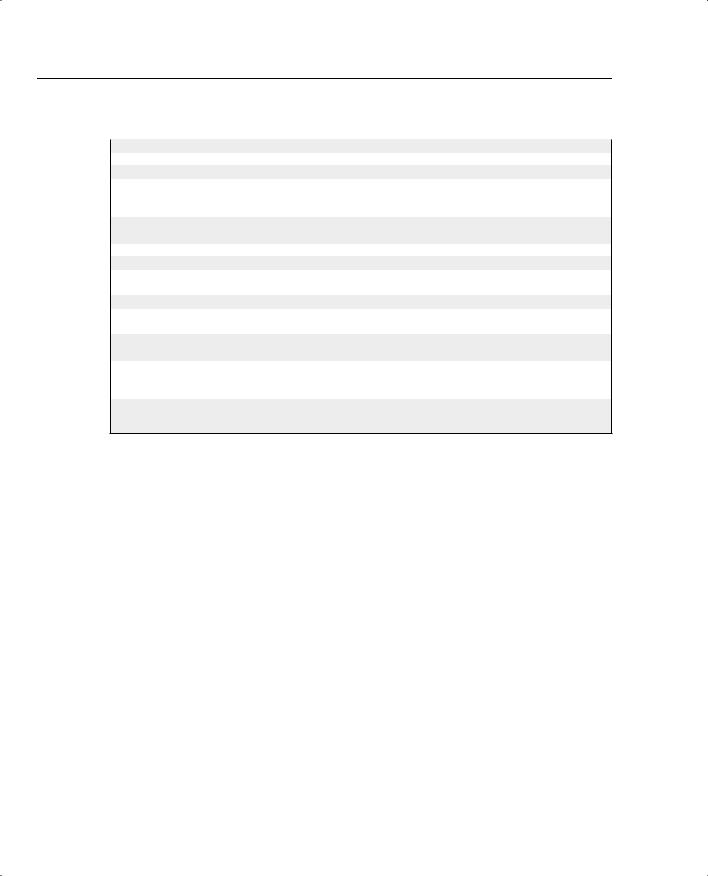
- •QoS Overview
- •“Do I Know This Already?” Quiz
- •QoS: Tuning Bandwidth, Delay, Jitter, and Loss Questions
- •Foundation Topics
- •QoS: Tuning Bandwidth, Delay, Jitter, and Loss
- •Bandwidth
- •The clock rate Command Versus the bandwidth Command
- •QoS Tools That Affect Bandwidth
- •Delay
- •Serialization Delay
- •Propagation Delay
- •Queuing Delay
- •Forwarding Delay
- •Shaping Delay
- •Network Delay
- •Delay Summary
- •QoS Tools That Affect Delay
- •Jitter
- •QoS Tools That Affect Jitter
- •Loss
- •QoS Tools That Affect Loss
- •Summary: QoS Characteristics: Bandwidth, Delay, Jitter, and Loss
- •Voice Basics
- •Voice Bandwidth Considerations
- •Voice Delay Considerations
- •Voice Jitter Considerations
- •Voice Loss Considerations
- •Video Basics
- •Video Bandwidth Considerations
- •Video Delay Considerations
- •Video Jitter Considerations
- •Video Loss Considerations
- •Comparing Voice and Video: Summary
- •IP Data Basics
- •Data Bandwidth Considerations
- •Data Delay Considerations
- •Data Jitter Considerations
- •Data Loss Considerations
- •Comparing Voice, Video, and Data: Summary
- •Foundation Summary
- •QoS Tools and Architectures
- •“Do I Know This Already?” Quiz
- •QoS Tools Questions
- •Differentiated Services Questions
- •Integrated Services Questions
- •Foundation Topics
- •Introduction to IOS QoS Tools
- •Queuing
- •Queuing Tools
- •Shaping and Policing
- •Shaping and Policing Tools
- •Congestion Avoidance
- •Congestion-Avoidance Tools
- •Call Admission Control and RSVP
- •CAC Tools
- •Management Tools
- •Summary
- •The Good-Old Common Sense QoS Model
- •GOCS Flow-Based QoS
- •GOCS Class-Based QoS
- •The Differentiated Services QoS Model
- •DiffServ Per-Hop Behaviors
- •The Class Selector PHB and DSCP Values
- •The Assured Forwarding PHB and DSCP Values
- •The Expedited Forwarding PHB and DSCP Values
- •The Integrated Services QoS Model
- •Foundation Summary
- •“Do I Know This Already?” Quiz Questions
- •CAR, PBR, and CB Marking Questions
- •Foundation Topics
- •Marking
- •IP Header QoS Fields: Precedence and DSCP
- •LAN Class of Service (CoS)
- •Other Marking Fields
- •Summary of Marking Fields
- •Class-Based Marking (CB Marking)
- •Network-Based Application Recognition (NBAR)
- •CB Marking show Commands
- •CB Marking Summary
- •Committed Access Rate (CAR)
- •CAR Marking Summary
- •Policy-Based Routing (PBR)
- •PBR Marking Summary
- •VoIP Dial Peer
- •VoIP Dial-Peer Summary
- •Foundation Summary
- •Congestion Management
- •“Do I Know This Already?” Quiz
- •Queuing Concepts Questions
- •WFQ and IP RTP Priority Questions
- •CBWFQ and LLQ Questions
- •Comparing Queuing Options Questions
- •Foundation Topics
- •Queuing Concepts
- •Output Queues, TX Rings, and TX Queues
- •Queuing on Interfaces Versus Subinterfaces and Virtual Circuits (VCs)
- •Summary of Queuing Concepts
- •Queuing Tools
- •FIFO Queuing
- •Priority Queuing
- •Custom Queuing
- •Weighted Fair Queuing (WFQ)
- •WFQ Scheduler: The Net Effect
- •WFQ Scheduling: The Process
- •WFQ Drop Policy, Number of Queues, and Queue Lengths
- •WFQ Summary
- •Class-Based WFQ (CBWFQ)
- •CBWFQ Summary
- •Low Latency Queuing (LLQ)
- •LLQ with More Than One Priority Queue
- •IP RTP Priority
- •Summary of Queuing Tool Features
- •Foundation Summary
- •Conceptual Questions
- •Priority Queuing and Custom Queuing
- •CBWFQ, LLQ, IP RTP Priority
- •Comparing Queuing Tool Options
- •“Do I Know This Already?” Quiz
- •Shaping and Policing Concepts Questions
- •Policing with CAR and CB Policer Questions
- •Shaping with FRTS, GTS, DTS, and CB Shaping
- •Foundation Topics
- •When and Where to Use Shaping and Policing
- •How Shaping Works
- •Where to Shape: Interfaces, Subinterfaces, and VCs
- •How Policing Works
- •CAR Internals
- •CB Policing Internals
- •Policing, but Not Discarding
- •Foundation Summary
- •Shaping and Policing Concepts
- •“Do I Know This Already?” Quiz
- •Congestion-Avoidance Concepts and RED Questions
- •WRED Questions
- •FRED Questions
- •Foundation Topics
- •TCP and UDP Reactions to Packet Loss
- •Tail Drop, Global Synchronization, and TCP Starvation
- •Random Early Detection (RED)
- •Weighted RED (WRED)
- •How WRED Weights Packets
- •WRED and Queuing
- •WRED Summary
- •Flow-Based WRED (FRED)
- •Foundation Summary
- •Congestion-Avoidance Concepts and Random Early Detection (RED)
- •Weighted RED (WRED)
- •Flow-Based WRED (FRED)
- •“Do I Know This Already?” Quiz
- •Compression Questions
- •Link Fragmentation and Interleave Questions
- •Foundation Topics
- •Payload and Header Compression
- •Payload Compression
- •Header Compression
- •Link Fragmentation and Interleaving
- •Multilink PPP LFI
- •Maximum Serialization Delay and Optimum Fragment Sizes
- •Frame Relay LFI Using FRF.12
- •Choosing Fragment Sizes for Frame Relay
- •Fragmentation with More Than One VC on a Single Access Link
- •FRF.11-C and FRF.12 Comparison
- •Foundation Summary
- •Compression Tools
- •LFI Tools
- •“Do I Know This Already?” Quiz
- •Foundation Topics
- •Call Admission Control Overview
- •Call Rerouting Alternatives
- •Bandwidth Engineering
- •CAC Mechanisms
- •CAC Mechanism Evaluation Criteria
- •Local Voice CAC
- •Physical DS0 Limitation
- •Max-Connections
- •Voice over Frame Relay—Voice Bandwidth
- •Trunk Conditioning
- •Local Voice Busyout
- •Measurement-Based Voice CAC
- •Service Assurance Agents
- •SAA Probes Versus Pings
- •SAA Service
- •Calculated Planning Impairment Factor
- •Advanced Voice Busyout
- •PSTN Fallback
- •SAA Probes Used for PSTN Fallback
- •IP Destination Caching
- •SAA Probe Format
- •PSTN Fallback Scalability
- •PSTN Fallback Summary
- •Resource-Based CAC
- •Resource Availability Indication
- •Gateway Calculation of Resources
- •RAI in Service Provider Networks
- •RAI in Enterprise Networks
- •RAI Operation
- •RAI Platform Support
- •Cisco CallManager Resource-Based CAC
- •Location-Based CAC Operation
- •Locations and Regions
- •Calculation of Resources
- •Automatic Alternate Routing
- •Location-Based CAC Summary
- •Gatekeeper Zone Bandwidth
- •Gatekeeper Zone Bandwidth Operation
- •Single-Zone Topology
- •Multizone Topology
- •Zone-per-Gateway Design
- •Gatekeeper in CallManager Networks
- •Zone Bandwidth Calculation
- •Gatekeeper Zone Bandwidth Summary
- •Integrated Services / Resource Reservation Protocol
- •RSVP Levels of Service
- •RSVP Operation
- •RSVP/H.323 Synchronization
- •Bandwidth per Codec
- •Subnet Bandwidth Management
- •Monitoring and Troubleshooting RSVP
- •RSVP CAC Summary
- •Foundation Summary
- •Call Admission Control Concepts
- •Local-Based CAC
- •Measurement-Based CAC
- •Resources-Based CAC
- •“Do I Know This Already?” Quiz
- •QoS Management Tools Questions
- •QoS Design Questions
- •Foundation Topics
- •QoS Management Tools
- •QoS Device Manager
- •QoS Policy Manager
- •Service Assurance Agent
- •Internetwork Performance Monitor
- •Service Management Solution
- •QoS Management Tool Summary
- •QoS Design for the Cisco QoS Exams
- •Four-Step QoS Design Process
- •Step 1: Determine Customer Priorities/QoS Policy
- •Step 2: Characterize the Network
- •Step 3: Implement the Policy
- •Step 4: Monitor the Network
- •QoS Design Guidelines for Voice and Video
- •Voice and Video: Bandwidth, Delay, Jitter, and Loss Requirements
- •Voice and Video QoS Design Recommendations
- •Foundation Summary
- •QoS Management
- •QoS Design
- •“Do I Know This Already?” Quiz
- •Foundation Topics
- •The Need for QoS on the LAN
- •Layer 2 Queues
- •Drop Thresholds
- •Trust Boundries
- •Cisco Catalyst Switch QoS Features
- •Catalyst 6500 QoS Features
- •Supervisor and Switching Engine
- •Policy Feature Card
- •Ethernet Interfaces
- •QoS Flow on the Catalyst 6500
- •Ingress Queue Scheduling
- •Layer 2 Switching Engine QoS Frame Flow
- •Layer 3 Switching Engine QoS Packet Flow
- •Egress Queue Scheduling
- •Catalyst 6500 QoS Summary
- •Cisco Catalyst 4500/4000 QoS Features
- •Supervisor Engine I and II
- •Supervisor Engine III and IV
- •Cisco Catalyst 3550 QoS Features
- •Cisco Catalyst 3524 QoS Features
- •CoS-to-Egress Queue Mapping for the Catalyst OS Switch
- •Layer-2-to-Layer 3 Mapping
- •Connecting a Catalyst OS Switch to WAN Segments
- •Displaying QoS Settings for the Catalyst OS Switch
- •Enabling QoS for the Catalyst IOS Switch
- •Enabling Priority Queuing for the Catalyst IOS Switch
- •CoS-to-Egress Queue Mapping for the Catalyst IOS Switch
- •Layer 2-to-Layer 3 Mapping
- •Connecting a Catalyst IOS Switch to Distribution Switches or WAN Segments
- •Displaying QoS Settings for the Catalyst IOS Switch
- •Foundation Summary
- •LAN QoS Concepts
- •Catalyst 6500 Series of Switches
- •Catalyst 4500/4000 Series of Switches
- •Catalyst 3550/3524 Series of Switches
- •QoS: Tuning Bandwidth, Delay, Jitter, and Loss
- •QoS Tools
- •Differentiated Services
- •Integrated Services
- •CAR, PBR, and CB Marking
- •Queuing Concepts
- •WFQ and IP RTP Priority
- •CBWFQ and LLQ
- •Comparing Queuing Options
- •Conceptual Questions
- •Priority Queuing and Custom Queuing
- •CBWFQ, LLQ, IP RTP Priority
- •Comparing Queuing Tool Options
- •Shaping and Policing Concepts
- •Policing with CAR and CB Policer
- •Shaping with FRTS, GTS, DTS, and CB Shaping
- •Shaping and Policing Concepts
- •Congestion-Avoidance Concepts and RED
- •WRED
- •FRED
- •Congestion-Avoidance Concepts and Random Early Detection (RED)
- •Weighted RED (WRED)
- •Flow-Based WRED (FRED)
- •Compression
- •Link Fragmentation and Interleave
- •Compression Tools
- •LFI Tools
- •Call Admission Control Concepts
- •Local-Based CAC
- •Measurement-Based CAC
- •Resources-Based CAC
- •QoS Management Tools
- •QoS Design
- •QoS Management
- •QoS Design
- •LAN QoS Concepts
- •Catalyst 6500 Series of Switches
- •Catalyst 4500/4000 Series of Switches
- •Catalyst 3550/3524 Series of Switches
- •Foundation Topics
- •QPPB Route Marking: Step 1
- •QPPB Per-Packet Marking: Step 2
- •QPPB: The Hidden Details
- •QPPB Summary
- •Flow-Based dWFQ
- •ToS-Based dWFQ
- •Distributed QoS Group–Based WFQ
- •Summary: dWFQ Options

296 Chapter 4: Congestion Management
would be discarded due to policing, because the cumulative rate for all traffic would exceed 400 kbps. The policer would have no way to decide to discard just the extra voice, but not video, because the policer acts on all traffic in the class. However, with the two lower-latency queues configuration, only the voice calls would lose packets due to policing, and the video conference would not have any packets dropped by the policer.
In effect, with multiple low-latency queues, you get more granularity in what you police. In fact, the most typical reason to use multiple low-latency queues is to support voice in one queue, and video in another.
Queuing does not differ when comparing using a single low-latency queue with multiple lowlatency queues in a single policy map. IOS always takes packets from the low-latency queues first, as compared with the non-low-latency queues (those with a bandwidth command), just like before. However, IOS does not reorder packets between the various low-latency queues inside the policy map. In other words, IOS treats all traffic in all the low-latency queues with FIFO logic.
In short, using multiple low-latency queues in one policy map does enable you to police traffic more granularly, but it does not reorder packets among the various low-latency queues.
Unfortunately, the DQOS and QoS courses and exams disagree with each other about where you can have more than one low-latency queue. The DQOS course states that only one lowlatency queue is allowed in a single policy map, whereas the QoS course states that multiple low-latency queues are allowed. So, you may talk to colleagues who have seen some Cisco documentation, or taken the DQOS class, and swear that only one low-latency queue is allowed. Thankfully, the chances are low that you would see a question distinguishing this fine point. However, you should be aware of the differences in documentation and the courses, so we made it a point to draw attention to the differences here.
IP RTP Priority
Before Cisco created LLQ, Cisco created two other tools that added a single priority queue to another queuing tool. IP RTP Reserve was the first of these two tools to be introduced, followed by the IP RTP Priority feature. With current IOS releases, Cisco recommends not using these older tools, but instead suggests using LLQ. However, because IP RTP Priority is currently on QoS exams, a brief explanation is warranted.
IP RTP Priority provides many features like LLQ, but with a few differences. It adds a PQ to either WFQ or to CBWFQ. It classifies VoIP payload traffic by classifying packets in a range of UDP port numbers, from which it only selects traffic from the even-numbered (VoIP payload) ports. Like LLQ, the PQ created by IP RTP Priority always gets serviced first, but the bandwidth reserved for this queue is policed to prevent it from taking over all bandwidth. Table 4-14 summarizes the main features and compares the features with LLQ.

|
|
|
Queuing Tools 297 |
|
|
|
|
Table 4-14 Comparison of LLQ and IP RTP Priority Features |
|
|
|
|
|
|
|
|
|
|
IP RTP |
|
Feature |
LLQ |
Priority |
|
|
|
|
|
Adds a priority queue to WFQ |
No |
Yes |
|
|
|
|
|
Adds a priority queue to CBWFQ |
Yes |
Yes |
|
|
|
|
|
Can classify on even UDP ports in a specified range |
Yes |
Yes |
|
|
|
|
|
Can classify on anything MQC can use to classify |
Yes |
No |
|
|
|
|
|
Reserves a configured amount of bandwidth |
Yes |
Yes |
|
|
|
|
|
Bandwidth is policed, so priority queue cannot exceed the |
Yes |
Yes |
|
configured bandwidth |
|
|
|
|
|
|
|
Currently recommended best queuing tool for low latency |
Yes |
No |
|
|
|
|
IP RTP Priority Configuration
To configure IP RTP Priority, you just add one additional configuration command to an interface that already uses WFQ. There are no additional show commands to list information about IP RTP Priority beyond the commands that apply to the underlying queuing tools (WFQ and CBWFQ). Table 4-15 lists the two configuration commands, and Example 4-9 lists several example configurations.
Table 4-15 Command Reference for IP RTP Priority
|
Command |
Mode and Function |
|
|
|
|
ip rtp priority starting-rtp-port-number port-number- |
Interface configuration mode; enables IP |
|
range bandwidth |
RTP Priority on a subinterface or interface |
|
|
|
|
frame-relay ip rtp priority starting-rtp-port-number |
FRTS (Frame Relay traffic shaping) map- |
|
port-number-range bandwidth |
class configuration mode; enables IP RTP |
|
|
Priority in an FRTS map class, which is then |
|
|
enabled on a subinterface or DLCI (data-link |
|
|
connection identifier) |
|
|
|
Example 4-9 IP RTP Priority Configuration Examples |
|
|
! Example 1
interface serial 1/0
description this interface will use WFQ and IP RTP Priority, with 30 kbps reserved
encapsulation hdlc
fair-queue
continues

298 Chapter 4: Congestion Management
Example 4-9 IP RTP Priority Configuration Examples (Continued)
ip rtp-priority 16384 16383 30
!
!Example 2 interface serial 1/1
description this interface will use CBWFQ and IP RTP Priority, with 30 kbps reserved encapsulation frame-relay
service-policy output my-policy ip rtp-priority 16384 16383 30
!Example 3
interface serial 1/3 encapsulation frame-relay frame-relay traffic-shaping
interface serial 1/3.1 point-to-point
description this subinterface will use FRTS per DLCI, plus WFQ and IP RTP Priority frame-relay interface-dlci 100
class my-shape
!
map-class my-shape frame-relay cir 128000 Frame-relay fair-queue
Frame-relay ip rtp-priority 16384 16383 30
Example 4-9 lists three different configurations for IP RTP Priority. The first example, configured on serial interface 1/0, shows a simple configuration on a point-to-point serial link using High-level Data Link Control (HDLC) encapsulation. The ip rtp-priority 16384 16383 30 command enables the feature, matching even-numbered UDP ports between 16384 and 32767. (The 16384 parameter is the base port number, and the 16383 parameter is the number of ports starting at the base port number.) The last parameter, 30, sets the guaranteed minimum bandwidth and the policing rate, just as the priority command did for LLQ.
The second example just shows IP RTP Priority enabled on a serial interface using Frame Relay. The ip rtp priority command enables the function on Frame Relay interfaces as well as HDLC interfaces. Also in the second example, RTP Priority is configured to work with CBWFQ, as evidenced by the service-policy subcommand under serial 1/1.
Finally, the third example shows RTP Priority along with Frame Relay traffic shaping (FRTS). Chapter 5 explains the details behind FRTS configuration. FRTS parameters are configured as subcommands of a command called map-class. Queuing, including IP RTP Priority, can be configured inside an FRTS map-class, which is then enabled on an interface, subinterface, or DLCI.
Cisco recommends LLQ be used for delay-sensitive traffic such as VoIP and interactive video traffic. However, in cases where CBWFQ and LLQ are not an option (for instance, when the IOS release is earlier than 12.0(7)T/12.1 Mainline), IP RTP Priority provides a good alternative for queuing delay-sensitive traffic.
